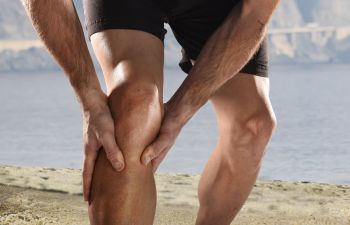As the temperatures start to drop, the jumpers come out and the rain jackets are dug out of the closet – all ready for another season of winter sports.
Winter focused sports such as football, soccer, netball and rugby, as well as many others, all ramp up right about now and unfortunately, so does the likelihood of experiencing shin, leg and foot pain.

With the start of the winter sports season, I always see a massive increase in shin splints, leg pain, heel pain and foot pain coming into the clinic, even before the season is really underway. However, there’s a few tips and tricks you can use to avoid this type of pain happening to you or, if you’re already experiencing it, how you can manage it better so it doesn’t get in the way of your game time.
First of all, we need to look at why this type of pain is so common at the start of the season. For most people, there’s been a sharp increase in the amount of running, jumping and impact work their legs are doing and this can certainly take its toll as your body adapts to the new load. Returning to winter sports can be a bit of a shock to your body.
Simultaneously, in our Perth climate, the dryness of the grounds and surfaces we play on also have an impact – quite literally! Until more rain comes and the grounds soften, the start of the season can see an unforgiving amount of impact and shock transferring up into your limbs with every sprint, jump and turn. The good news is, with the onset of a wetter winter, this impact does tend to lessen.
So what can you do to survive the start of the season and help your body adjust well
1.Stretching your assets
Stretching your calf muscles, as well as your hamstrings, quads and muscles of your hips will help those muscles lengthen and maintain their flexibility. This will not only help with recovery and reduce post-game
2. Foam rolling
Foam rolling can also help with your recovery and muscle pliability. Consistently using a foam roller to massage your muscles can help to remove reduce some tightness and remove waste products like lactic acid. Just don’t forget to stretch as well and always ask myself or a suitable health professional for advice on the best techniques for foam rolling.
3. Wearing good footwear
By now, you’ve probably worn in the new kicks or pulled out your trusty favourite shoes from last season. Ensure that your shoes are
4. Taking care of your recovery
Starting your season with good recovery habits will set you up for
5. Treating pain early
Often I see shin splints, leg pain and foot pain quite far into the season and it’s been building from a little “niggle” to now being a full blown case of “on the bench”. If you are experiencing leg or foot pain, or any pain for that matter, it’s important to get it treated early before it gets worse. Often a few visits to a Soft Tissue OT or other health professional at the start of your pain can get you back playing
6. Staying fit in the off season
Many of the issues contributing to leg, shin and foot pain can be minimised if you maintain your fitness and stay active during your offseason. So many athletes work hard all season to get to their peak fitness and conditioning, only to let it all go and have to start all over again come next year. Maintain your leg strength, endurance and tolerance to playing during your offseason and next season will be a much smoother start and help you avoid these issues.
If you or someone you know is experiencing pain in returning to sports and you’d like to chat about it, feel free to get in touch with me. Alternatively, you can book an appointment online here and we can work together to keep you injury free this season.
